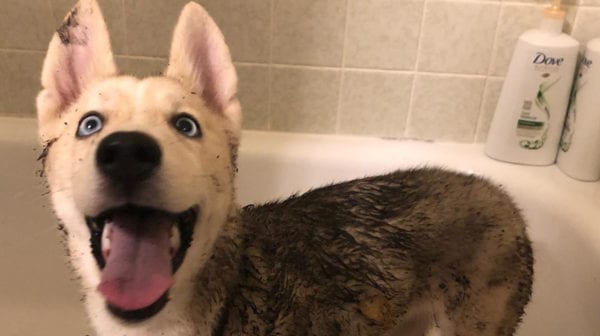Having pets in your home can bring so much joy, but if you’re someone who deals with a pet dander allergy, those feel-good vibes can be dampened by symptoms like sneezing and itchy eyes.
But what is pet dander exactly? Pet dander is tiny flakes of dead skin that animals naturally shed, and these flakes can trigger allergic reactions in some people.
But the good news is that there are ways to reduce pet dander in your home to not only help lessen allergy symptoms but also—and more importantly—allow you to keep enjoying life with your pets.
We spoke with a veterinarian and an allergist to understand the ins and outs of pet dander and uncover easy, practical tips for reducing its presence in your home—so you can breathe a little easier.
In This Guide:
What Is Pet Dander?
Pet dander consists of tiny—often microscopic—skin particles that are shed by animals. These particles become airborne and can linger in the environment, sticking to surfaces like furniture, bedding, and clothing.
While pet dander is most commonly associated with cats and dogs, any pet with fur or feathers, including rabbits, birds, horses, and even rodents, can produce dander.
Dander vs. Dandruff: What’s the Difference?
While they sound similar, dander and dandruff are not quite the same.
Dandruff is a skin condition that causes visible flakes of dead skin to fall off the pet’s body—much like the dandruff humans experience. These are larger flakes that you might notice on your pet’s fur or bedding.
Dandruff is often a sign of an underlying issue, such as dry skin, allergies, parasites (like fleas and mites), skin infections, or poor grooming habits.
Dander, on the other hand, consists of tiny dead skin cells that animals shed as part of their skin’s natural renewal process. As new skin cells form, old ones die and are shed as microscopic particles known as dander.
What does dander look like? Because it’s so small, it’s typically invisible to the naked eye.
How Pet Dander Can Affect Pet Parents
When pet dander becomes airborne and comes into contact with people’s skin, eyes, or respiratory system (via inhalation), it can trigger allergic reactions in those who are sensitive to it.
An allergic reaction occurs when a person’s immune system overreacts to certain proteins, known as allergens—that are usually harmless.
For example, most people who are allergic to dog dander are reacting to a protein called Canis familiaris allergen 1 (Can f 1), explains Karen Hsu Blatman, MD, an allergy and immunology specialist and section chief at Dartmouth Hitchcock Medical Center, in Lebanon, New Hampshire.
Similarly, the major allergen in cat dander is Felis domesticus allergen 1 (Fel d 1).
It’s important to note that while dander is the most common source of a pet allergy, people can also be allergic to the proteins in pet saliva, urine, and feces.
Types of Pet Dander Allergic Reactions
People who are allergic to pet dander may experience a variety of reactions, including:
Nasal-Based Reactions
Nasal reactions occur when the immune system overreaction leads to inflammation of the nasal passages, causing a range of uncomfortable symptoms, including:
- Sneezing
- A runny or stuffy nose
- Itchy, red, or watery eyes
- An itchy nose, roof of mouth, or throat
- Itchy ears
- Postnasal drip
- Coughing
- Facial pressure and pain
Skin Reactions
For some pet parents, dander exposure can result in allergic dermatitis, a skin reaction caused by allergens coming into direct contact with the skin.
Symptoms of dermatitis can include:
- Hives (raised, red patches of skin)
- Itchy skin
- Eczema (inflamed, itchy, and often cracked skin)
Asthma
While it’s rare, some people can experience anaphylaxis—a severe, potentially life-threatening allergic reaction characterized by symptoms such as difficulty breathing, swelling of the throat, rapid drop in blood pressure, and loss of consciousness—due to pet dander.
More commonly though, significant reactions manifest as asthma attacks. When pet dander is inhaled, it can irritate the airways, causing inflammation and narrowing. This can trigger asthma symptoms such as:
- Coughing
- Wheezing or a whistling sound when exhaling
- Shortness of breath
- Chest tightness and pain
In severe cases of asthma, people can have trouble breathing or feel like their throat is closing, which can be a medical emergency, Dr. Hsu Blatman says.
How To Get Rid of Pet Dander
“Unfortunately, it’s not possible to completely remove pet dander from the home, but it can be reduced and managed in a few different ways,” says Danielle Rutherford, VMD, a veterinarian at Westside Veterinary Center, in New York, New York.
So, while it may not be realistic to expect to get rid of cat dander or dog dander entirely, here are some practical steps that can significantly help minimize dander and create a more comfortable living environment:
1. Vacuum and Clean Surfaces Frequently
Carpets, rugs, and upholstered furniture are common spots where dander collects. Regular vacuuming of these surfaces can help control dander buildup.
For best results, Dr. Hsu Blatman suggests using a vacuum with a high-efficiency particulate air (HEPA) filter.
“A controlled trial has reported lower allergen levels and clinical improvement in asthma measures in homes cleaned with vacuums equipped with HEPA filters, compared with vacuums without specialized filters,” she says.
Don’t forget to clean hard surfaces, such as floors, counters, and shelves, daily, and wash your pet’s bedding and other belongings frequently.
2. Replace Carpet with Hardwood Floors
While carpet may feel cozy, it tends to trap pet dander, dust, and other allergens. It’s also harder to clean thoroughly.
If possible, replace carpeted areas with hardwood, tile, or other smooth flooring. These surfaces are much easier to keep allergen-free, as they don’t trap dander like carpet does.
Regular sweeping and mopping can further reduce allergen buildup.
3. Use an Air Purifier
Air purifiers can help reduce pet dander in the air, but not all models are equally effective.
“Use a room air cleaner with a HEPA filter, particularly one that directs filtered air toward the individual’s head during sleep,” says Dr. Hsu Blatman.
“In homes with forced air heating, consider installing a whole-house filtration system with disposable HEPA filters that are regularly changed,” she adds.
Additionally, when the weather permits, opening windows to ventilate your home can also help reduce the allergens in the air.
4. Create an Allergen-Free Bedroom
As much as you love cuddling with your pet at night, keeping them out of your bedroom can make a big difference in reducing pet dander allergies.
Because you spend several hours sleeping, reducing allergen exposure during that time can help minimize symptoms and give your body a break from dander overnight.
5. Regularly Bathe or Clean Your Pet
If you’re allergic to dog dander, giving your pup regular baths with a dog shampoo for dander can help control buildup.
“This may vary a bit by breed, but washing every one to two weeks is most helpful,” Dr. Rutherford says.
Because you’ll be bathing your dog quite frequently, it’s important to use a moisturizing shampoo so that their hair coat doesn’t lose its natural oils and become excessively dry, Dr. Rutherford advises. She recommends using a gentle pet shampoo, such as Virbac® Epi-Soothe®.
What about a cat shampoo for dander?
Bathing cats to reduce dander is typically not recommended. Research suggests that to effectively reduce dander, cats would need to be bathed twice a week, which can be stressful and unhealthy for most cats.
Instead, Dr. Rutherford recommends using a waterless shampoo like Purina® Pro Plan® LiveClear® shampoo spray or Burt’s Bees® dander reducing wipes.
6. Feed Your Cat an Allergen-Reducing Diet
If you suffer from cat allergies, consider feeding your cat Purina Pro Plan LiveClear Dry Cat Food—the first and only cat food scientifically proven to reduce the amount of allergens your cat produces.
This innovative food has been shown to reduce the major allergen in cat hair and dander (Fel D 1) by an average of 47%, starting as early as the third week of feeding.
7. Seek Medical Help
If you’ve tried the above at-home strategies but are still struggling with pet dander allergy symptoms, consult your doctor. They can assess your condition and suggest additional treatments, such as allergy medications or immunotherapy, which may provide more long-term relief.
FAQs About Pet Dander
Q:How long does pet dander stay in a house?
A:Pet dander can remain in a home for months, as the tiny particles can stick to furniture, carpets, clothing, and walls. Without regular cleaning, dander can become embedded in soft surfaces, continuing to trigger allergic reactions long after a pet has left the area.
Q:Can pet dander make you sick?
A:While pet dander itself doesn’t cause illness, it can trigger allergic reactions in sensitive individuals, leading to symptoms such as sneezing, itchy eyes, a runny nose, and asthma attacks.
Q:Do all dogs produce dander?
A:Yes, all dogs produce dander, but some dog breeds may produce less dander than others, making them more suitable for people with allergies.
Q:What is dog dander? What is cat dander?
A:Dander refers to the small flakes of dead skin that dogs and cats shed as part of their natural skin renewal process.
Some people are allergic to the proteins in dog dander, most commonly a protein called Can f 1.
The major allergen in cat dander is Fel d 1.
More on managing shedding in your home:
Share:
















